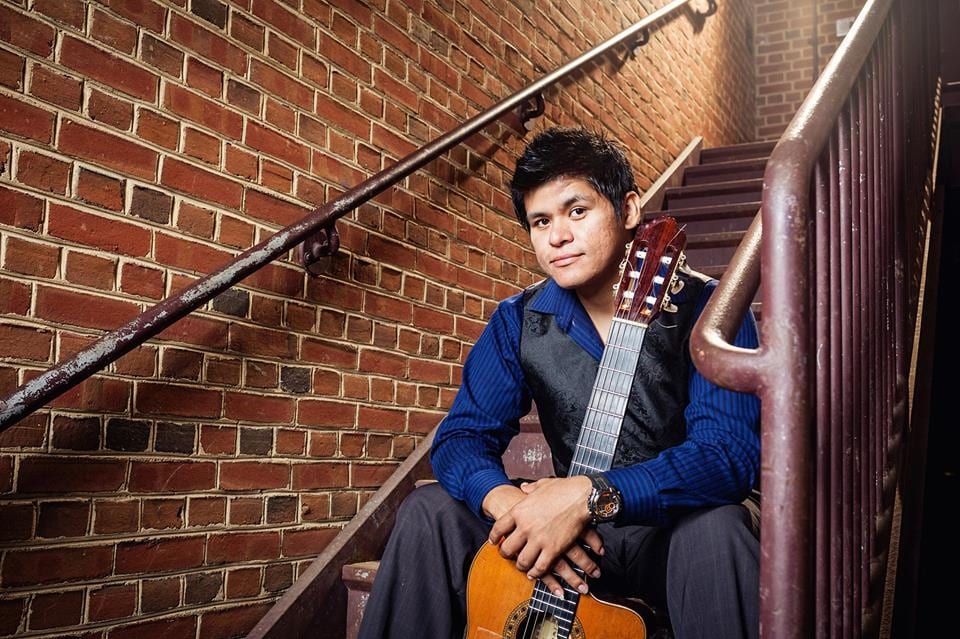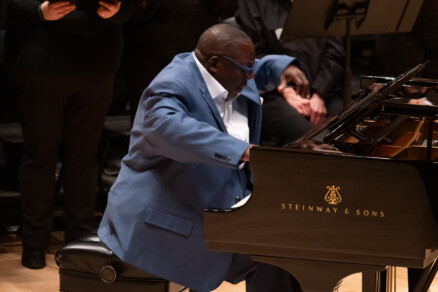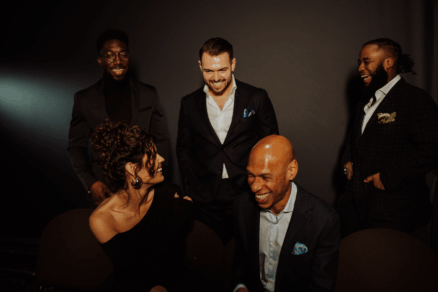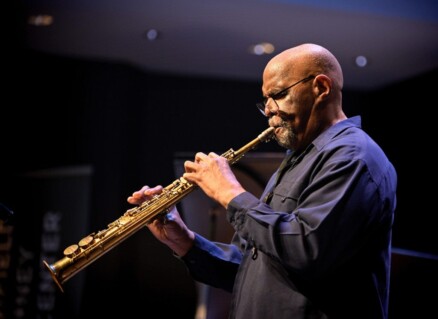Cristian Perez’s Musica Mundi: Guitarist With a Global Appetite Shares His Vision

D.C. embodies the spirit of musical fusion. For decades, artists in the nation’s capital have stretched the boundaries of genre and style. Today, few are as enthusiastically committed to that pursuit as guitarist Cristian Perez. Both trained as a classical guitarist and educated in jazz, Perez has returned in recent years to the South American folk of his youth. His frequent gigging across styles has led to a vibrant blend of influences in his career as a leader.
Born in Buenos Aires, Argentina, Perez moved to the United States in 2002. During his one-year course of study at the Levine School of Music and an extensive career at George Mason University, where he obtained both his bachelor’s and master’s degrees, he studied under a wide variety of respected mentors including Berta Rojas, Rick Whitehead and Larry Snitzler. He was the Strathmore Artist in Residence for February of 2015.
Perez’s 2016 release, Anima Mundi, fully represents the breadth of his musical explorations. The album draws on a central concept of human interconnectedness vis a vis the animal kingdom, with tracks named after animals or other elements of nature. Perez uses animal symbolism as a vessel for different cultures’ musical content: the Indian elephant’s song summons the sound of tablas, or the condor’s guitar grooves reminiscent of Andean music.
Last week, CapitalBop sat down with Cristian to ask him some questions in preparation for his show at Twins Jazz this Thursday.
CapitalBop: So Cristian, you moved to the states in high school, but you played guitar growing up in Buenos Aires as well, right?
Cristian Perez: Not too much at first. In Buenos Aires I played electric guitar in rock bands; listened to a lot of punk music, and then heavy metal. I started to play much more when I moved to the U.S.
CB: Oh, wow. Heavy metal?
CP: Yeah, and neo-classical metal. From there I started to get interested in classical music, and started to take lessons for classical guitar, and went to study it in school. I started studying, like, Paganini, a lot of the Bach Suites, that’s made for lutes, and then it’s transcribed for guitar. A lot of the harmony is pretty similar, it’s just that the main difference is that you have a rhythm section, you know, and add distortion. But the sound is pretty similar, harmonically and melodically.
CB: Awesome. So, when did jazz start to become a part of that mix?
CP: At George Mason University, I was studying guitar there, and we all had to take electives; and there was a required jazz—jazz improvisation. And I was always interested in improvisation, just by itself, and so I turned to jazz because of the nature of the class, the emphasis was on jazz. And once I decided to study improvisation in general, it was inevitable to study jazz… I started, you know, on the classics, the Charlie Parker and Miles Davis, but I also got into the jazz that I really liked, kind of the more—fusion-y, the world music, kind of like the Pat Metheny Group.
CB: And there’s a lot of guitarists in that vein, isn’t there.
CP: Exactly. And even Mike Stern has been influenced by a lot of types of music. I got into that, and I really liked it. At Mason, I decided to get my master’s in jazz. I was able to study with both teachers, and take classes from both styles. And in the middle of that, I had my background from Argentina, and South American music I had taken for granted. So I decided to kind of cultivate it more, and listen to the music I had listened to as a kid. I started doing that more, started listening to neo-tango from Argentina.
CB: So you had a homecoming, of sorts, to that music you grew up with.
CP: Yeah, it was in the background; I never realized, was aware, that that music was who I am. But later I realized that it was a big part of me.
CB: Yeah, absolutely. Well, to a casual jazz listener, I guess, people would call it “world music”— but what is that kind of music? What are the real roots, the styles, that you would say influence your music, from that…folk world?
CP: Well, besides the classical guitar and the jazz, there’s a little bit of the drive of the early stages of the heavy metal—there’s sort of an implied drive sometimes. A lot of it is the folk music, the simple chords, simple melodies.
CB: And that’s Argentinian folk, mostly?
CP: Yeah, well, Argentinian—I would say, South American, Indian…from the Andes. My parents were born in Bolivia, so a lot of the music they listened to was from that area, a lot of the music played with the churangos, the string instruments from that area. Very warm music. Very different from the folk from the United States, for example or Mexico, or Brazil. It has a very different vibe.
CB: Yeah, yeah, it’s really distinctive.
CP: I was also interested in different types of music; I always tend to say “yes” to every opportunity, it’s like a bad habit, almost.
CB: [laughs] It’s the best bad habit you’re gonna have, I feel like.
CP: [chuckles] It’s good and bad. For example, in some places, some venues I want to play, they say, “well, you have to play with this artist, because we don’t have any more openings,” and I end up playing with very cool artists, like this percussionist from South India—and that got me started on this thing from South India, this band from Bangladesh.
CB: I thought I heard some tabla on a couple tracks on your album.
CP: Yeah. Just being exposed to that, just being able to work with people like that and having to learn—it’s just the music is very cool, because, there’s music of all kinds and there’s always music that you can like. In any musical style, there’s some music that I can like. Some music I might not be that attracted to, but if I listen closely to more recordings, more artists, there’s always something that I’ll like and I wish I could take, and study a little bit, get into it, and kind of saturate my stuff with it for a little bit, and then let it happen, let it come out.
CB: It’s funny you mention Mike Stern, because he went to high school in D.C., as well. And then you said you grew up on punk music, and that’s cool, because that’s also a style that people source to the D.C. scene, a few decades ago. Do you think that living in the D.C. area has shaped your personal sound, like, how do you think that’s worked for you?
CP: I think that because this area is very diverse, there’s a lot of people from India, there’s a lot of Asian people—a lot of Koreans especially, in this area. So there’s a lot of diversity, especially when I went to school—I think George Mason is one of the most diverse schools I’ve heard of. A lot of my friends are from completely different countries, cultures. I think there’s a lot of opportunities, like at the Kennedy Center; there’s a lot of stuff, a huge variety of music, a lot of festivals.
CB: So you just soaked that up, growing up here, I suppose.
CP: Yeah, yeah. That’s something that I also like about Mike Stern, because he does that kind of—and Pat Metheny, too, then do the kind of thing where they borrow stuff and they make it their own. My goal is not to copy, not to imitate the style. Even my own folk music from Argentina, it’s just like kind of filtered by me, and I let it come out. There’s a lot of imitations; everyone is different, and everyone can make their own really cool music.
CB: Well, you know, you have all these diverse influences going into your sound: punk, and jazz, and classical, and these traditional styles. Do you feel that any of those styles is a home for you, like a home style that you start from when you write? Or is it a toss-up from project to project?
CP: I actually don’t feel like that. Usually when I start, I start with the kind of music that I like, the music that I play; you know, when I pick up the guitar, I’m a classical guitarist. But then after I started looking at more music, like jazz, it was more difficult to play as a classical guitarist; I had to change my thinking, from classical music. It’s almost like uncomfortable to a point, because I cannot play this, or this; but at the same time, it’s refreshing, because I always try to—for example, if I’m playing in a swing band, like very old jazz like the 1940s, very old songs, [when they used to] play banjo… when I play that…I kind of try to almost be an actor, like, okay, tonight, I’m going to play this sort of jazz. Kind of like an actor, I try to be convincing enough to be that. Or if I’m playing in a classical group, like if someone is doing a classical ballet, and they need a classical guitarist—I have to do something, I tell myself, this is who I am for today. For myself, the stuff that I write, it’s just…whatever I am.
CB: So it’s just a natural voice that’s some sort of combination of those things.
CP: Yeah. I try to be in each one, when I have to, when I’m not a bandleader. But when I am a bandleader, on my own projects,
CB: Alright, so your most recent album, Anima Mundi, seems to have this underlying philosophy about how we as humans fit into the natural world. Can you elaborate on that whole philosophy?
CP: Yeah. It wasn’t like, before recording the album, it had that theme… I always like to watch documentaries, and I’ve always liked nature. I like animals a lot, and I identify myself with a lot of the animals, and things. So I think that came out naturally. I discovered the term “Anima Mundi,” also, by accident. I discovered later that different philosophers [used the term].
CB: So how do you use music to explore that concept, for you, or how did that concept naturally apply to the music you were already making?
CP: Well, at the beginning, for example, the “Persistent Elephant,” which is the Indian-sounding tune, I wanted to write something in that style. I was playing with some sounds, and the piece was coming out, and I tried to imagine an animal that was of a tradition of some kind; I thought of the Indian Elephant. [For the] “relentless dragon,” it has a sort of Japanese influence. I think I have a picture in mind, and then let the music fill in the gaps
CB: Do you do it music-first, usually, you’ll have the sound?
CP: It depends. It helps me a lot to have an image first, because that narrows it down so I have—it’s kind of like, I go back and forth, so I’ll be practicing, and I come up with something, and that makes me think of something [else]… And that’s the cool thing of that idea, that relationship between the music and the concept of Anima Mundi: there’s no boundaries. The only boundaries are the ones we set up. There’s animals that go between countries, they migrate over time. They don’t care what country they are [in]. That’s my vision of music: it shouldn’t matter if I’m playing bebop, or if I’m playing tango, or whatever music. In a specific way, I think it should flow freely—it shouldn’t matter what you call it.
CB: Yeah! It’s this global connection thing. So— tell me a little bit about your band. How did you arrive at this instrumentation? Flute, accordion, guitar, bass, percussion? How does that complement this musical vision you’re talking about.
CP: I started with electric bass, drums and guitar, a trio, and then I added sax. It sounded really good, but I wanted to go in a different direction, more folk-y. I didn’t want it to sound just like a jazz quartet, or like a fusion band. So I realized I needed an upright bass, for the acoustic sound. Then my friend Yana [played in a] concert…and I realized I liked the flute much better than the saxophone, because of the tone. And then I needed some chordal accompaniment, and the bandoneon is the perfect [addition]. It’s really hard to get an bandoneon player in this area, but it just happens that this guy Emmanuel, is a really good tango player and lives in the area. I play in his group sometimes. He’s a really good complement to the flute, because the flute is very precise. The flute comes from a classical background, so the bandoneon complements it very well. It’s very melodic, very laid back.
CB: I notice that when you talk about the instrumentation, you’re speaking less about the instruments themselves and more about the people who are playing them. You’d say the people in your band, their personalities add to the project?
CP: Definitely, yeah. For example, I know with the flutist that I have—Yana, she’s from Bulgaria—I can write anything I want and she can play it. I know that with the bandoneon player, he’s a little different; he doesn’t come from a classical background, he’s not used to reading complicated things. But he’s used to improvising very melodic lines. So when I write stuff, I give him room to embellish melodies and improvise, and stretch the time a little bit. And the flute is very tight melodies, very tight lines.
CB: Yeah. And people have been—I suppose, Duke Ellington was super famous for doing that kind of stuff, and it’s just been this great formula since. You can tell with your group… you all haven’t been together too long, have you?
CP: I guess, two years.
CB: Yeah. You sound like you’ve been playing together for much longer than that. It’s this kind of groupthink that I think probably comes in part from you writing for your musicians specifically. And they add to the final product, I’m assuming.
CP: Yeah. It’s a lot of editing in rehearsal. Because I bring things, and if they don’t really work, I change them. I’m always changing stuff, and updating it, until I’m happy. I think that the CD was a good point, where I was happy with the arrangements, and I was happy with the players and how they contributed. So the CD is a good representation of that.
CB: So, what can people expect to hear at your set at Twins, your upcoming set? Is this performance going to differ at all from the sound on Anima Mundi?
CP: Yeah, we’ve added some things different from the album, of course. And then I have a new drummer that I recently connected with, he’s from Argentina and he plays percussion and a lot of world percussion, like marimba and a lot of things. He’s gonna have a different flavor, maybe more folk. We’re gonna—we’re also gonna do some standards, some different styles from other arrangements that we haven’t done in a little while. Some new covers as well.
Cristian Perez plays this Thursday, June 18, at Twins with his quartet: Yana Hristova on flute, Daniel Brown on bass and Joe McCarthy on drums. Two separate sets at 8 & 10 p.m. Tickets are $10.
Cristian Perez, DC, DC jazz, jazz, Twins Jazz, U Street, Washington


